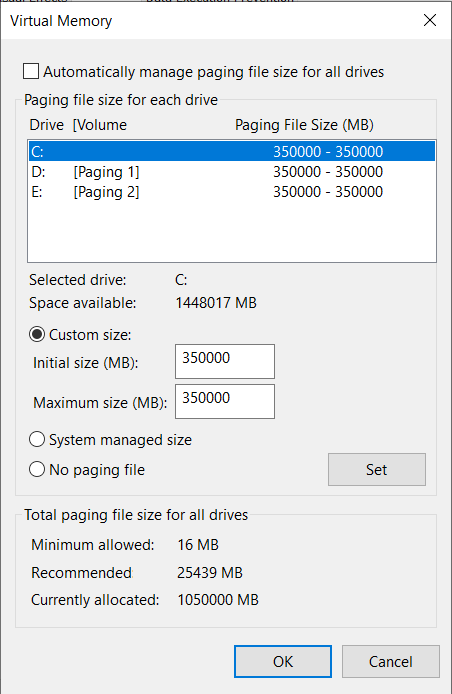About austinpop
Retained
-
Member Title
Credo In Aures
Personal Information
-
Location
Austin, TX
-
I personally just use a full disk partition, but cannot claim to have tested it both ways. But just logically, I don't think it should make a difference. The usage of the cache is dynamic, and based on disk accesses in real time. I'm not aware of any reaon, nor would it make sense, for disk partitioning to have any bearing on this. Ultimately, as long as disk utilization stays well below 100%, you've achieved your objective.
-
@rayon With regards to paging, I'm finding it even more beneficial to split the paging space over multiple drives. This prevents the paging I/O to saturate any single drive, thus becoming a bottleneck, and enables CPU to run at high utilization. In fact, on my new machine (14900K/192GB), I provisioned 3 Samsung 990 Pro NVMe drives, and I set up paging as shown: In hindsight, this was probably overkill, but I do strongly recommend 2 drives, it really helps with speed on systems where thermals are otherwise under control, as yours is.
-
@rayon If you have a 13900k (cooled with AIO) and 96gb 5600mhz RAM machine, you should be able to do DSD1024x1 without any issue. The main thing you need to make sure is that you have a paging file(s) defined that can accommodate the virtual address footprint of PGGB. This does not necessarily mean a lot of paging during processing (manifested as disk I/O). There just needs to be enough room for the virtual memory PGGB allocates. Use ZB's previous post or the website to guide you. You want the paging to be on your fastest NVMe SSD drive, and you can use ZB's storage calculator to decide how big a paging space to set. I personally allocate a huge paging space of 1TB, spread over 3 NVMe drives, but I tend to process a lot of long classical tracks over 30 mins. This version of PGGB has been drastically performance-optimized in terms of memory management, and so the code is very smart about avoiding unnecessary paging I/O. But it does have to allocate virtual memory, so this is really why you need the large paging file, to accommodate the large virtual memory footprint. Also, PGGB DSD is a CPU-bound workload, so it will stress your cooling solution, and could drive some systems to thermally throttle. One common way that this happens is if your motherboard has "removed Intel limits" and allows the power demand to grow unboundedly. One way to control this, on ASUS mobos, is to go to Multicore Enhancements in AI Tweaker, and select "Disabled - enforce all limits." This will cap the package power the mobo delivers to the CPU to the Intel limit of 253W. I should write a more detailed post on PGGB performance at some point.
-
Yes, very good point. I also noticed this on my brand new 14900K/192GB machine (will post on this later). It seems to be some default behavior in W11 that reduces the CPU allocated to anything that is not running in the foreground. This is actually nice if you are running PGGB while doing other work on the system. It will reduce the performance of PGGB in the background, but this also means your fans and AIO pump (if applicable) will slow down and your system will be quieter. However, you have to remember to return PGGB to the foreground before you walk away. Running PGGB "as Administrator" keeps PGGB running at full speed.
-
I'm delighted to see that PGGB DSD is now officially released, and I hope many more will enjoy what I and the other beta testers have been enjoying for some time now. When @Zaphod Beeblebrox first mentioned to me that he was working on a PGGB DSD implementation, my question to him was: why bother? After all, PGGB's genesis was on the Chord DAVE, and very much focused on perfecting PCM upsampling. However, ZB reminded me, not that I should have needed reminding, that some DACs, especially those that have a pure 1-bit DSD pipeline, were an even better candidate for upstream upsampling, and he had reached a point where he was confident he could deliver the same benefits of PGGB's reconstruction for DSD256, DSD512, or even DSD1024. That intrigued me. I remember the first set of DSD512 sample tracks he invited me to listen to. They were promising, but not particularly better to my ears on my Vinnie Rossi L2 DAC/L2i SE amp than my reference 32/16FS PGGB PCM tracks. OK, he said, these were processed in 2 stages of 32 x 16. Let's see what you think of 64 x 8. Wow, now this was a clear step up! But wait, he said, see what you think of 128 x 4, 256 x2, and finally DSD512 in one stage. Each was better than the last, but 512x1 DSD512 was an absolute epiphany. Here is how I described it to him: Oh man, you’ve hit a home run with this latest set! The SQ is just scary good. MUCH better than 16fs PCM. Where to start! Compared to PGGB PCM 16fs: more dynamic larger sound stage More transparent Equal or better transients Tighter bass Most impressive is the treble. Sweet and refined. Not colored, just so clean and free of grain. I've now gargle blasted dozens of albums to DSD512, and I think my initial impressions continue to describe what I am hearing. Just yesterday, I was listening to Bach Brandenburg Concertos by Rinaldo Alessandrini and Concerto Italiano (Naive label 16/44.1), upsampled to PGGB DSD512. This is a fantastic recording with excellent texture, dynamics, and immediacy. But in DSD512, it became transcendent. The slightly bright tilt of the recording is gone, replaced by a rich and refined tonality. Rather than dissect the differences, it's easier to describe the overall effect -- the music just has a sense of ease, and sounds more convincing, more real, and so much more emotionally engaging. Of course, you will only hear this with the DACs that will benefit from DSD upsampling, and ZB maintains a list on the website. As it happened, during the weeks when PGGB DSD was being beta tested, I had a fair number of suitable DACs pass through my system, so here is a brief survey of what I heard. 1. Vinnie Rossi L2 DAC First up, my current and reference DAC, the Vinnie Rossi L2 DAC/L2i SE amp. I've already described my impressions above. This DAC benefits greatly from both PCM and DSD upsampling, since its default PCM "NOS" filter will pass upsampled 16fs PCM through to the AK 4497EQ chips delta-sigma modulator. However, because of its 1-bit DSD bypass in the chip, DSD512 bypasses a lot more. It passes right through to the output FIR filter and on to the analog output stage. Anyway, I'm not an expert on DAC design, but the net of this is PGGB DSD512 stands head and shoulders above PGGB 32/16FS PCM (which in turn is head and shoulders above the native tracks). On this DAC, DSD512 is the way to go. I did experiment with DSD256, but it was a step down from DSD512. 2. T+A DAC-200 This DAC has separate PCM and DSD pipelines, with the DSD pipeline being pure 1-bit, and ideal for upsampled DSD512. On this DAC too, while 32/16FS upsampled PCM made a big improvement (using the NOS2 filter setting) over native files, the star of the show was DSD512! I had some trouble sending DSD1024 files to this DAC (no doubt some driver issues I didn't have time to troubleshoot), so I don't know if DSD1024 would sound even better. 3. T+A SDV 3100 HV This is the much bigger and 4+ times more expensive sibling of the DAC-200. While the design of the digital pipelines of these DACs is almost identical, the SDV 3100 HV has substantially more features, and upgraded everything: analog stage, power supplies, chassis, isolation, and much more. If ever you needed convincing that the sound quality of a DAC depends on so much more than just the digital pipeline, you should A/B compare these two DACs side by side. As good as the DAC-200 is -- and it is fantastic! -- the SDV 3100 HV is far better in every dimension. Anyway, this is not a DAC review, back to PGGB. As on the DAC-200, the SQ uplift on this DAC with DSD512 over native files was massive. Unlike the DAC-200, the firmware of this DAC does not actually have a "NOS" mode for PCM, so I only listened to upsampled DSD. Also unlike the DAC-200, this DAC actually implements an NAA (Signalyst Network Audio Adapter), so I was able to send it DSD1024 files over Ethernet, even though I had the same troubles over USB. There are 2 DSD filters, DSD1 and DSD2. DSD1024 only plays with DSD1, while DSD512 sounded best with DSD2. As to which I preferred: I actually found DSD512 with DSD2 setting to sound better than DSD1024, although both sounded outstanding. Listening to PGGB upsampled DSD512 on the SDV 3100 HV was just about as close to the best SQ I have ever heard in my system. Sadly, the loan spell ended in no time, and the lucky owner picked it up and took it home. A sad day for me! 4. dCS Bartok APEX with Lina Clock My review of this DAC should be coming out soon, but I wanted to mention it here as an example of a DAC where the effect of PGGB was modest. This is not surprising really, as the dCS Ring DAC architecture does not really have any bypass modes for either PCM or DSD. While the dCS DACs accept up to 24/8FS inputs, the internal pipeline first upsamples to 16FS before modulating to the Ring DACs multibit SDM format. Yet, PGGB did help. While the improvement with upsampling to 24/8FS was small, it was consistent. A bit more substantial was the improvement with upsampling to DSD128, which is the max input DSD rate over DoP. Would the PGGB upsampling SQ benefit be big enough to motivate a dCS owner to go to the effort? I'm not so sure. Certainly not to the extent a T+A owner would be! I hope this helps new and existing PGGB users.
-
Makes sense. PGGB-only posts in the PGGB thread. Ditto HQP. Only posts covering both should go here.
-
Nice! Where?
-

AXPONA 2024, Schaumberg (Chicago USA) April 12-14 Audio Show
austinpop replied to John Hughes's topic in General Forum
I have been to at least 2 AXPONAe where it has snowed, so always nice to see this! -

AXPONA 2024, Schaumberg (Chicago USA) April 12-14 Audio Show
austinpop replied to John Hughes's topic in General Forum
That's a relief! I am hoping to attend this year. -
Agree with you Rex. I think I was typical in my hopes and expectations: I just did not want SQ to degrade. So it was a pleasant surprise when I heard a (mild) uplift. Yup, this is the question.
-
Um, OP here. Hasn't this discussion perhaps strayed a wee bit off-topic from "The Audio Impact of Solar Panels and Battery Backup?" 😏 Perhaps time to move this to its own thread, @The Computer Audiophile?
-
You are the Goliath of this field going after a small competitor. Justify it however you like — the rest of us can see you're just being a bully. I'll let @The Computer Audiophile decide if a Member of the Trade trashing a competitor's product is OK or not. First point: only ZB is the "PGGB guy." I'm not a DSP expert, nor do I have any business affiliation with PGGB. I paid exactly what all other customers did for my license. As for you being puzzled about your competitors internals: I'll bet you are! Isn't that the very nature of business?
-
You have always been shown respect here, yet you take every opportunity to disparage PGGB. That’s not classy, and I’m puzzled why you do it. in any event, soon enough folks using PGGB > HQP will not have any need to do so, so hopefully we can just coexist.
-
@OE333 I'm helping someone out who has an SDV 3100 HV. I know this is the DAC-200 thread, but since these DACs are so similar, I hope it's OK to ask here. What is the best DSD Filter to use if sending DSD256 or DSD512 to the DAC over USB? Is it DSD2? And for DSD1024, is it DSD1? What about PCM 16FS (705.6/768)? There does not seem to be NOS1/NOS2 options on this DAC, unlike the DAC-200.
-
If my early impressions are any indication, this will be worth the wait!
















